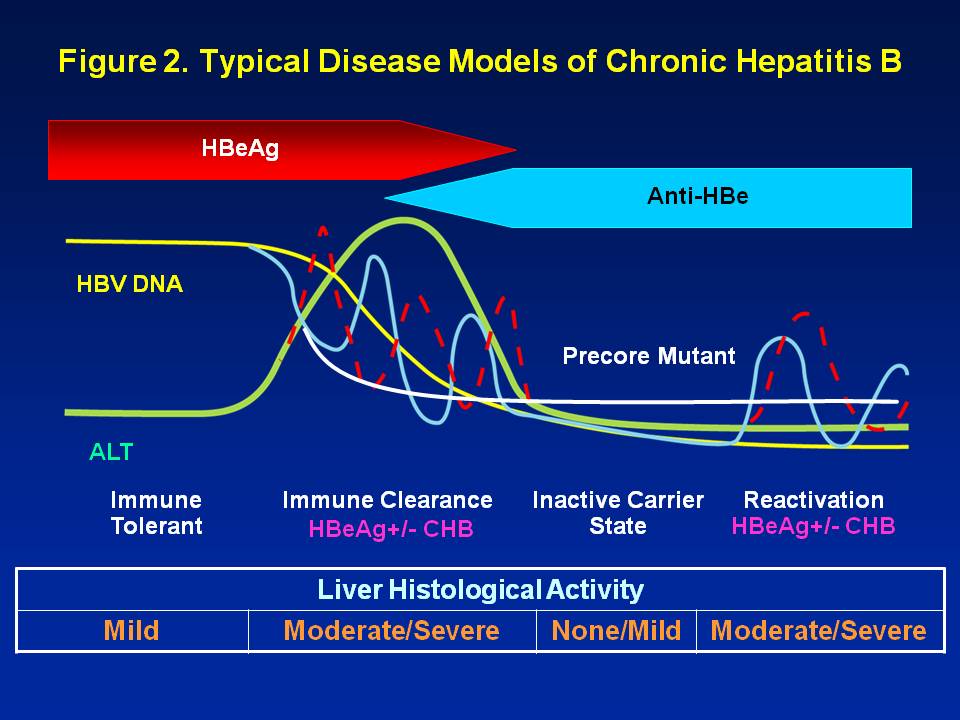In the last chronic hepatitis B stages blog, we looked at the HBeAg-Positive Chronic Infection (also known as immune tolerant).
At some point the immune system recognizes the hepatitis B virus and the chronically infected person will enter a phase referred to as the HBeAg–positive chronic hepatitis- (also known as immune reactive/immune clearance). During this phase blood work will show that you are HBeAg positive, with lower levels of HBV DNA when compared to the HBeAg-positive chronic infection/immune tolerant stage, and increased ALT (SGPT) levels. (Remember, it is not at all unusual for kids to have viral loads in the millions or even billions.) During this “clearance” phase the immune system is actively attacking infected liver cells. This is both good and bad. On the good side, if the immune system is able to “beat” the virus, the person will go through HBeAg seroconversion and lose the HBeAg antigen. This means that HBeAg will go from positive to negative and the HBeAb antibody, or anti-HBe will go from negative to positive. This results in significant decrease in the hepatitis B virus level, often to an undetectable level, and normalization of ALT/AST liver enzymes and other liver function blood test results. Successful HBe serconversion moves you into the HBeAg-negative chronic infection/inactive carrier phase.
When the immune system activates and starts attacking infected liver cells, it not only kills the virus, but also the host liver-cells. You may not feel any of this, but your ALT (SGPT) and AST (SGOT) lab values will be elevated. These enzymes are released when there is inflammation caused by liver cells that are injured or killed. Your doctor may see a mild, moderate or high levels of ALT elevation reflecting inflammation in the liver. Ultimately the problem is how much inflammation and liver damage occurs during the process of HBeAg seroconversion. Your doctor will need to carefully monitor liver enzymes, liver function and use non-invasive calculations and diagnostic imaging to get a clearer picture of what is happening with your liver.
It is possible a person will quickly and spontaneously move into and out of the HBeAg-positive chronic hepatitis/immune reactive phase, and with a limited amount of inflammation and liver damage. However, some people may cycle up and down for years with intermittent flares, which are evidenced by ALT elevations which may be as high as 10 times above the upper limits of normal (normal is 35 IU/mL for men and 25 IU/mL for women) when in the immune reactive phase. While the immune system attacks infected liver cells, viral replication will decrease and ALT levels will elevate as infected liver cells die in the battle. If successful, the immune system response will result in HBe seroconversion – losing HBeAg, gaining the HBe antibody, and a decline of the viral load (HBV DNA) to very low or undetectable levels, and the normalization of ALT/AST and other liver enzyme levels.
Unfortunately, that might not be enough, and the immune system may not be able to put up a big enough fight permitting HBe seroconversion to a less active or HBeAg negative chronic infection /inactive carrier phase. Evidence of this is ALT levels that go back down, and viral replication that goes back up. (Note the above diagram.) This cycling up and down over time will be reflected in lab work if a liver specialist monitors you regularly over time. If you are not having your ALT levels regularly monitored (every few months), then you may miss these cycles of intermittent elevations or flares over time. It is during these elevations that liver damage occurs, and you will likely be completely unaware, unless you have lab work done while liver enzymes are elevated, or you wait until there are symptoms and significant liver damage.
It is during the immune clearance phase when treatment is sometimes recommended. It is true that a chronically infected person will eventually serconvert HBe spontaneously – without treatment, but most liver specialists choose to treat in order to prevent years of ALT elevations and flares and subsequent damage to the liver.
If you appear to be in the HBeAg-Positive Chronic Hepatitis / Immune Reactive phase, be sure to ask your doctor about treatment with first line antivirals such as tenofovir (TAF or TDF) and entecavir. Don’t be afraid to ask questions about your hep B infection and the health of your liver. Treatment with antivirals greatly reduce liver disease progression and can be lifesaving.











![5-17-13[1]](https://wp.hepb.org/wp-content/uploads/2013/05/5-17-1311-1024x701.jpg)





